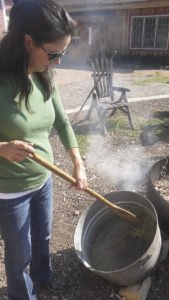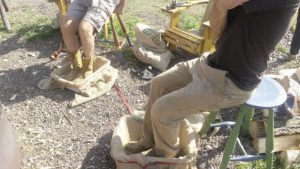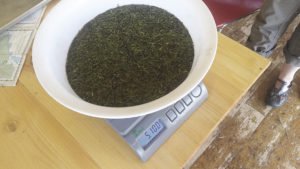On a sunny afternoon in early September, I was paddling down a winding river in northern Minnesota. Flanked with reeds and tall grasses and the odd beaver lodge, the edges of this marshy wetland were interspersed with stalks of wild rice. I was with a group of North House Folk School students, and most of us were in unfamiliar territory. But before we knew it, the river opened to denser patches of rice about a mile downriver.

I hadn’t seen wild rice before this adventure—at least I wasn’t sure whether I had. During a recent canoe trip north of Atikokan, Ontario, there were many times when we paddled through low-lying wetlands in hopes of landing some rice, but unsure of exactly what to look for or what to do with it in the instance that we got lucky.
“Do you think that’s it over there?” my partner asked me, pointing to long stalks with brownish-pink flowers that looked like feathers of grain growing from the water. I had no idea, but having noticed a small body of water called Rice Lake on one our of maps not far from our route, it left us intrigued to find out.
As luck would have it, I was able to take a ricing course in Grand Marais and learned a few facts about manoomin, as it’s known in Anishinawbe culture. One of them being that it grows in shallow lakes or slow-moving water with an inlet and outlet. And harvesting is a two-person job: someone usually sits or kneels in the bow with two tapered wooden sticks, using one to bend the rice over the side of the boat and the other to knock the kernels into the bottom. Meanwhile, the other person has to skillfully maneuver the canoe through densely-vegetated water. Because rice grows in soft layers of peat, loam or clay-like soil, a long, tapered pole with duck-billed footings are used to steer and move the boat forward. It’s a pretty effective core workout as you try to keep your balance without having the canoe lose momentum in the grass.

Our harvest wasn’t much to brag about. We drew up to each other’s boats to compare our hauls for the day, but none of us had more more than a layer of rice that lightly dusted the bottom of our boats. As we unloaded our gear from the river, there was an unspoken sense of mild disappointment that we wouldn’t go home with much.
But in the end, we were thankful. Processing the rice was where the real work began, and it was pain-staking, humbling labour. Traditionally, the rice is dried, parched over a fire, treaded by foot to separate the kernels from the hull, and winnowed by hand until all that’s left are sleek, dark grains of rice ready for cooking. The footwork to jig the rice loose from its hull is an art in itself. At the end of the class, our group of nine produced just five pounds of finished rice. And it took us all day.
It left me with an earnest appreciation for the meticulous work involved in gathering and processing rice, a traditional food staple for communities living around the Great Lakes, who considered it a sacred food. The Menominee nation of northern Wisconsin reflect this relationship in their name, which translates to “wild rice people” in the Ojibwe language.
Over decades, wild rice production has become industrialized and commercialized to the point where it’s not unusual to see “wild” rice sold at bargain prices in supermarkets and gas stations throughout North America. The majority of these products are actually farmed in rice paddies, where the site is drained and allowed to dry before combining, although machine-harvesting of lake rice is practiced too.

Tom Lind has been ricing the traditional way in northern Minnesota since the late ‘70s and has witnessed the ebb and flow of the crop from year to year. Because rice re-seeds naturally but doesn’t germinate at the same time, some areas may not produce high for two or three years in a row, but in ideal conditions, a boom has the potential to follow. Some seeds can stay dormant for up to a decade or longer.
“It varies a lot from bed to bed and it’s partly because of the weather. Water table fluctuation is a problem,” he said. Heavy rains or flooding while rice is forming can easily uproot the plant. It’s also heat-sensitive and susceptible to fungus that can affect its quality.
In some years, Tom has filled his boat with more than 300 pounds of wild rice in a single day, but he confesses it’s been a long time since that’s happened. When I spoke to him in northern Wisconsin in mid-August, he and other ricers predicted a low yield in that area, which faced big rains and wash-outs in June.
Although most of his rice has been gathered and finished the traditional way, Tom now takes his harvest to a commercial processor and is building his own thrasher. “I’m getting too old for it,” he remarks reluctantly. “I enjoy the whole process, and I enjoy eating something that I put so much of my heart into.” Laborious but meaningful, part of why he enjoys ricing is to retain a traditional practice. “I just like the old way of doing things, and to keep that knowledge alive.”
